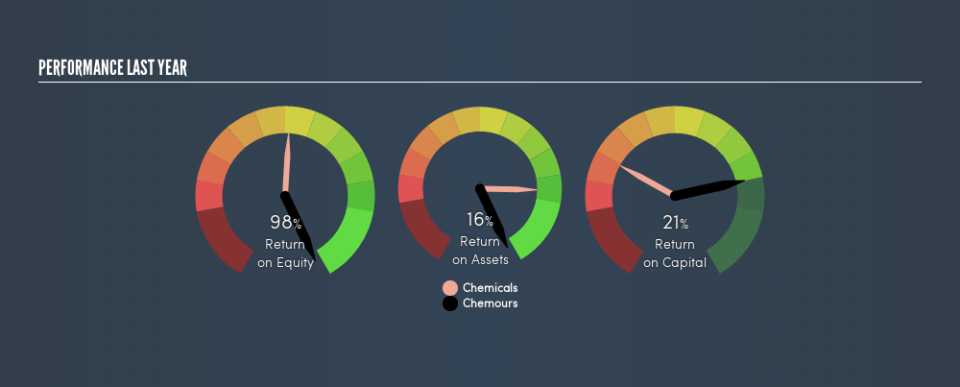Here’s What The Chemours Company’s (NYSE:CC) ROCE Can Tell Us

Today we’ll look at The Chemours Company (NYSE:CC) and reflect on its potential as an investment. To be precise, we’ll consider its Return On Capital Employed (ROCE), as that will inform our view of the quality of the business.
First, we’ll go over how we calculate ROCE. Second, we’ll look at its ROCE compared to similar companies. And finally, we’ll look at how its current liabilities are impacting its ROCE.
Understanding Return On Capital Employed (ROCE)
ROCE measures the amount of pre-tax profits a company can generate from the capital employed in its business. All else being equal, a better business will have a higher ROCE. Ultimately, it is a useful but imperfect metric. Author Edwin Whiting says to be careful when comparing the ROCE of different businesses, since ‘No two businesses are exactly alike.’
How Do You Calculate Return On Capital Employed?
The formula for calculating the return on capital employed is:
Return on Capital Employed = Earnings Before Interest and Tax (EBIT) ÷ (Total Assets – Current Liabilities)
Or for Chemours:
0.21 = US$1.2b ÷ (US$7.4b – US$1.7b) (Based on the trailing twelve months to December 2018.)
So, Chemours has an ROCE of 21%.
See our latest analysis for Chemours
Does Chemours Have A Good ROCE?
ROCE can be useful when making comparisons, such as between similar companies. Using our data, we find that Chemours’s ROCE is meaningfully better than the 12% average in the Chemicals industry. We would consider this a positive, as it suggests it is using capital more effectively than other similar companies. Setting aside the comparison to its industry for a moment, Chemours’s ROCE in absolute terms currently looks quite high.
In our analysis, Chemours’s ROCE appears to be 21%, compared to 3 years ago, when its ROCE was 4.7%. This makes us think about whether the company has been reinvesting shrewdly.
When considering this metric, keep in mind that it is backwards looking, and not necessarily predictive. Companies in cyclical industries can be difficult to understand using ROCE, as returns typically look high during boom times, and low during busts. ROCE is, after all, simply a snap shot of a single year. Since the future is so important for investors, you should check out our free report on analyst forecasts for Chemours.
What Are Current Liabilities, And How Do They Affect Chemours’s ROCE?
Liabilities, such as supplier bills and bank overdrafts, are referred to as current liabilities if they need to be paid within 12 months. Due to the way ROCE is calculated, a high level of current liabilities makes a company look as though it has less capital employed, and thus can (sometimes unfairly) boost the ROCE. To check the impact of this, we calculate if a company has high current liabilities relative to its total assets.
Chemours has total liabilities of US$1.7b and total assets of US$7.4b. As a result, its current liabilities are equal to approximately 23% of its total assets. A minimal amount of current liabilities limits the impact on ROCE.
The Bottom Line On Chemours’s ROCE
This is good to see, and with such a high ROCE, Chemours may be worth a closer look. Of course you might be able to find a better stock than Chemours. So you may wish to see this free collection of other companies that have grown earnings strongly.
I will like Chemours better if I see some big insider buys. While we wait, check out this free list of growing companies with considerable, recent, insider buying.
We aim to bring you long-term focused research analysis driven by fundamental data. Note that our analysis may not factor in the latest price-sensitive company announcements or qualitative material.
If you spot an error that warrants correction, please contact the editor at editorial-team@simplywallst.com. This article by Simply Wall St is general in nature. It does not constitute a recommendation to buy or sell any stock, and does not take account of your objectives, or your financial situation. Simply Wall St has no position in the stocks mentioned. Thank you for reading.

 Yahoo Finance
Yahoo Finance 
